The Day of the Martyrs, Bucharest, November 30th 1940 - "Foreign Correspondent" by R. St. John
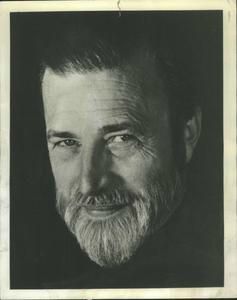 (Image source) Robert St. John (1903-2003), a globetrotting journalist who was on the scene or on the air for most of the 20th century's major news events: mobster Al Capone's grip on Chicago, the Nazi onslaught through the Balkans, the London Blitz, D-day, the end of World War II and Israeli independence - wrote more than a score of books after he was chucked off the radio during the McCarthy Era.
(Image source) Robert St. John (1903-2003), a globetrotting journalist who was on the scene or on the air for most of the 20th century's major news events: mobster Al Capone's grip on Chicago, the Nazi onslaught through the Balkans, the London Blitz, D-day, the end of World War II and Israeli independence - wrote more than a score of books after he was chucked off the radio during the McCarthy Era.
Among his books were three autobiographies - one aptly titled "Foreign Correspondent" - which cannot even begin to cover St. John's century of living nor his 4 million miles of travel, observing and reporting from 88 different nations.
I have just finished reading the three chapters describing the atmosphere in Bucharest in 1940: Who was there in terms of reporters from all over the world, what was going on and the stories they phoned through, the political situation which was so terribly unstable, the reactions of the street, the coup d'etat of 1940-41, King Carol's abdication and departure with Magda Lupescu, King Mihai's terrible situation left alone and still such a child... incredible, visual scenes told at first hand as he stood (or hid) and observed that kept me hooked enough to reread again and again. All the more fascinating is how this man seemed to understand the Romanian psyche so well.
One particularly shocking account is of the consequences wrought by the death of Corneliu Codreanu (Captain of the Iron Guard: The Legion of the Archangel Michael) in 1938 ordered by King Carol and then what happened two years later. I was horrified to read the sick mysticism, fanatacism and debased cruelty carried out by the legionnaires - and am all the more horrified to see that the Legion is still in existence today (though underground, I guess) with much support and plenty of online sites and that a handful of people I know on FB have Codreanu down as a 'like' on their lists of interests...
Here is the account given by Robert St John, copied out from the book with (...) when I cut to continue the story. I hope I am not breaching copyrite (I can't find this anywhere online), but I so want to share this with you and have added links and pix when possible:
[Sarah's note: Carol II has scarpered with Magda Lupescu, a very young and confused King Mihai has remained (forbidden to leave by Antonescu) with Queen Mother Helen who rushed to be with her son and the devastating earthquake of November 1940 (7.4 on the Richter scale) has just hit Bucharest.]
p.191, Foreign Correspondent, by Robert St John, published 1957
"It took Bucharest a long time to get back to normal. For weeks there was debris everywhere one looked. We wondered what could possibly happen next. Except for London, no city in the world had been on the front pages of the American newspapers in the past few months as often as Bucharest. But now we were getting tired of it. We hoped that the violence of man and the violence of nature were over, at least for a while.
There were exactly two weeks of calm before something happened which put us back on page 1 again and shocked the world.
When Codreanu and his thirteen lieutenants were taken, one cold November night in 1938, from their cells in Doftana prison and killed, members of the execution squad and all the officials involved pledged themselves never to reveal the burial place, well knowing that if members of the Legion of the Archangel Michael ever got their hands on the remains they would indulge in an orgy of mysticism, martyrolatry and hysteria which might end, as did all Legion excesses of emotion, in a new wave of fratricide.
During the earthquake, although nearly a hundred prisoners at Doftana were killed, the cell in which Codreanu had been held was undamaged. This "Miracle of Doftana," as the legionnaires called it, may have been one of the things that spurred them on in their attempt to find out exactly what had happened to their Capitanul.
Finally, after nearly two years, someone talked. On that night in 1938 a police truck had been sent to Doftana and Codreanu and the thirteen, handcuffed, were loaded in. The truck stopped in a forest near Jilava prison, on the edge of Bucharest, where the men were killed by a firing squad of gendarmes. Then the corpses were taken to Jilava, where they were buried close by the prison in a ditch twenty-seven feet long by five and a half wide. To hasten decomposition, the bodies were drenched with sulphuric acid, then a large quantity of quicklime was shovelled in on top of them. Finally, two tons of concrete were poured into the ditch. When the job was done, an oath of secrecy was taken by all those involved.
Having discovered the secret, a crowd of legionnaires went to Jilava, removed the two-ton concrete slab and exposed the crypt. They later claimed they had been able to identify Codreanu's remains by three small crosses he always wore around his neck and by his wedding ring and that each of the thirteen was similarly identified by jewelery and religious emblems. Actally, although the censors refused to permit us to communicate this fact, the chemicals had done their work so well that nothing was left in the pit which in any way resembled the remains of human bodies. What eventually was put into fourteen separate coffins was really little more than fourteen different piles of earth.
It was probably just this - the frustration of finding so little that was recognisable of the mortal remains of their Capitanul - that stirred such a blood lust in the legionnaires, who, even without provocation, were capable of considerable premeditated brutality.
Immediately after Carol's abdication, the Legion forced Antonescu to order the arrest of sixty-four men they said had had some part in the killing of their leader. Among them were a former Premier, four former cabinet members, including a Minister of Justice, three generals, the gendarmes who had done the shooting and the former police chief of Bucharest, known as 'The Protector' because of his responsibility for years for the safety of Magda Lupescu. The sixty-four had been locked up in Jilava to await trial.
Looking down into the open crypt, the legionnaires voted immediate vengeance, and at 3:30am stormed the prison, overpowered the guards, took away the keys, found the cells of the sixty-four, awakened them and then slaughtered them.
The official Legion announcement said the sixty-four were "killed on the spot where Codreanu had been murdered." Eye-witnesses, however, said the blood lust had been so strongly worked up in the legionnaires that they were unable to control themselves long enough to transport their victims to the forest; instead, they did them in on the spot with shovels, hammers and pickaxes and after all sixty-four were dead, the legionnaires mutilated the bodies in an orgastic display of hate rarely equalled in modern times by human beings anywhere.
Then they procured fourteen green-coloured coffins decorated with gold, put in them what they called the "remains" of Codreanu and the thirteen and hauled them to the Ilie Gorgani Orthodox church in Bucharest. There a dowen or more Orthodox priests who were legion members themselves were ordered to chant and pray over the bodies night and day until they were given permission to stop. Another battery of priests was taken out to the ditch beside the prison and ordered to do likewise there.
Every church in Romania was commanded on pain of severe punishment to say continuous Masses for the repose of the soul of the Capitanul. It was announced that the state funeral would be held the following Sunday.
Antonescu and Sima (a fanatic, named Vice-Premier by Antonescu to appease the legionnaires - Sarah's note) issued communiques condemning the murder of the sixty-four and calling on the men responsible to surrender immediately, at the same time urging the public to be tolerant and understand how it was that they had been angry enough to lose control of themselves. But the killers of the sixty-four did not surrender. Instead, they defiantly went en masse to the Church of Ilie Gorgani and prayed before the fourteen caskets. Then they went on their way. No one, not even Antonescu, the Conducator, had the courage to order their arrest.
That same day, four judges favourable to the Legion were ordered to conduct a posthumous retrial of the fourteen, so that if by chance they were found "not guilty", their memory could be "rehabilitated". The trial was short and in some respects farcical. No witnesses against the legionnaires were heard because most of them had been murdered the night before. Hundreds of relatives of the "defendants" were present, dressed in black. Their wailing almost drowned out the "judicial proceedings." After several hours of pseudo-legal palavering, the judges solemnly announced the fourteen defendants "not guilty."
(...) During the next two days we lived through a reign of terror much more frightening than a nine-intensity earthquake. Anarchy is like a forest fire when it begins to spread across a country. In many provincial towns local legionnaires, not knowing how else to show that they too, had feelings, stormed through Jewish quarters, killing, looting, burning.
The next day, Bucharest legionnaires murdered two of the best-loved men in all Romania, Dr Virgil Madgearu, a former Minister of Finance and one of the leaders of the Peasant Party, and sixty-nine year old Dr Nicolae Iorga, a distinguished-looking man with a long white beard who had once been Premier, had several times lectured in the United States, was respected as a scholar and political pundit and was universally known as "the Teacher of the Nation."
(...) Seven legionnaires called at Dr. Iorga's home and ordered him to go with them. They walked the aging man at a fast clip for three hours in the direction of Jilava. As they walked they conducted his "trial". He had to remain silent while the seven in green shirts argued whether or not he should be put to death. When they reached the forest near the prison, they took a vote. Four were for death.
"I expected this," was all Dr. Iorga said.
What the censor never permitted any of us to say was that before they killed the distinguished scholar they stuffed a copy of a liberal newspaper he edited down his throat, pulled out his long white beard hair by hair, and then tortured him still further in a deeply unspeakable manner.
These last two murders inspired other legionnaires to put several hundred Romanian intellectuals to death. (...)
By the night of the second day, it was virtual civil war. The army held Brasov. The Legion held Craiova and Turnu-Severin. From Ploiesti came reports of two thousand dead "Jews and leftists". That was the expression the censor required us to use.
Coler brought me a story of how the thirty men who had killed the sixty-four at Jilava had joined a suicide pact. They put thirty revolvers on a table, shook hands for the last time, drank a goblet of their own blood, then picked up the thirty guns and shot themselves.
The censor permitted me to send the story, but two hours later asked me to send a correction. There had been only twenty-six men involved. One hour later I was called again to the censor's office.
"Here is an official communique. You are required to send it at once!"
The communique said the suicide pact had been entirely untrue and that fitting punishment would be devised for anyone who had circulated such malicious news abroad.
(...)
It was a mad place. For weeks it had been blood, blood, blood, blood in one form or another. Elsewhere there was a war going on. In England thousands of people were being killed by bombs. Romania was technically neutral. Yet here the populace was committing race suicide!
(...)
On Friday night, we went to the Church of Ilie Gorgani. From a distance, it looked like opening night of a new film in Hollywood. Strong searchlights played on the entrance of the church, which was draped in green and on an immense white tower which had just been erected were emblazoned the words:
CAPITANUL CODREANU - PRESENT!
The queue of people waiting to gape at the coffins stretched for four city blocks. The interior of the church flickered with hundreds of small candles placed there by the public. Larger candles were held by an honour guard of a hundred legionnaires. Clouds of incense smoke from immense urns made the air difficult to breathe. A corps of priests chanted unceasingly. Codreanu's coffin was elevated a little above the others and all of them were nailed shut, for obvious reasons.
Th next morning, Bucharest was astir before dawn. Two years to the day had passed since Codreanu and the thirteen had been killed. The Legion of the Archangel Michael was determined that on his anniversary they would put on a show no one would ever forget. They did.
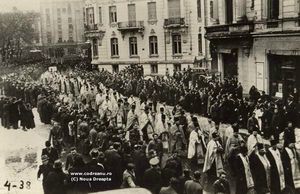 (Image source) Of all the memories of my life, from childhood to yesterday, happy or sad, none stands out as vividly as this one. Not because there was anything beautiful or pleasantly impressive about it. The 155,000 spectators and participants looked like normal human beings. They all had arms and legs, wore dresses or trousers, smoked cigarettes, bought newspapers, talked, got hungry and in many other respects behaved normally. Yet they seemed to be people gone mad. That day under the banner of Christianity they were doing honour to fourteen murderers, fourteen leaders of a terroristic organisation which just this week had inflicted on the country a fresh wave of bloodletting, sadism, masochism and horror.
(Image source) Of all the memories of my life, from childhood to yesterday, happy or sad, none stands out as vividly as this one. Not because there was anything beautiful or pleasantly impressive about it. The 155,000 spectators and participants looked like normal human beings. They all had arms and legs, wore dresses or trousers, smoked cigarettes, bought newspapers, talked, got hungry and in many other respects behaved normally. Yet they seemed to be people gone mad. That day under the banner of Christianity they were doing honour to fourteen murderers, fourteen leaders of a terroristic organisation which just this week had inflicted on the country a fresh wave of bloodletting, sadism, masochism and horror.
The memory will always remain vivid because I saw that day how frightening religious ecstasy can be when it gets out of control. Some of us feared, as we watched and listened, that the generation of so much emotionalism in so many thousands of responsible people would be bound to have frightful repercussions. Our fears turned out to have been justified.
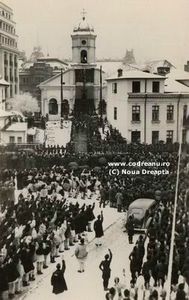 (Image source) What we saw that day reminded me of what happens when a lynch mob works itself into a frenzy. This was a lynch mob of 155,000 people. Almost every imaginable device for stirring the emotions was used on them before the day was over.
(Image source) What we saw that day reminded me of what happens when a lynch mob works itself into a frenzy. This was a lynch mob of 155,000 people. Almost every imaginable device for stirring the emotions was used on them before the day was over.
And there was not a single person in the ENTIRE country who had the courage to stand up and shout:
"STOP! This way lies madness!"
They all either threw themselves into the orgy or stood by, in fear of their lives if they uttered a word of reproach.
On November 30 1940, assassins and terrorists were not only heroes, but were saints for a day.
Actually, Codreanu and the thirteen were later canonised by the Orthodox Church as "national saints".
(...)
All shops, offices, schools and public buildings were ordered to remain closed for the day. Also the stock exchange. In other parts of the country public Masses were to be said continuously from dawn to dusk. All newspapers were ordered to print that day either in green ink or on green paper. They were also to pay their respects to the memory of the "martyrs" in prose and verse, in picture and photograph, in every trick of the printing art. Every bell in Romania was to be tolled for thirty minutes, starting at 10h30am. All buildings in Bucharest were to be draped with green flags and green bunting.
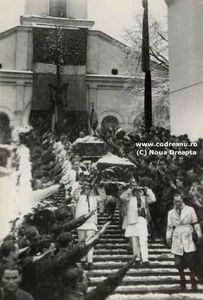 (Image source) No one disobeyed any of these orders, for this was the Day of the Martyrs and the martyrs' friends were in control.
(Image source) No one disobeyed any of these orders, for this was the Day of the Martyrs and the martyrs' friends were in control.
Foreign correspondents received personal invitations to attend. (...) We stood in the press stand which had been erected in the public square in front of the church.
Beside us was a great wooden altar with nearly a hundred steps leading up to it. The steps were lined with funeral urns which poured forth smoke from the burning incense. On the steps were fourteen green caskets and Codreanu's at the top. Also on the steps were altar boys and 168 pallbearers plus the legionnaires who would carry the trays of cakes which, by Orthodox custom, must go to the grave with a man so he will not be hungry after internment.
(...)
Antonescu the dictator, who in less than six years would be put to death himself, after trial as a war criminal, was there in black riding breeches and green shirt. Vice-Premier Sima had on a pair of green coveralls. Both had revolvers around their waists.
The theme of the day was expressed in signs nailed up everywhere:
CAPITANUL CODREANU - PRESENT!
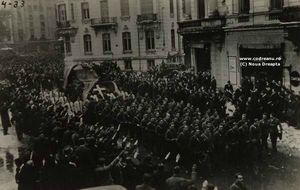 (Image source) The first people permitted into the little church were members of the fourteen families. Their sobs served to prime the emotions of everyone else.
(Image source) The first people permitted into the little church were members of the fourteen families. Their sobs served to prime the emotions of everyone else.
When the service finally began, the coffins were carried into the church. It took two and a half hours for the ecclesiastical ceremony. (...)
Finally, the service over, the funeral cortege got under way, led by hugh dignitaries of the Orthodox Church in their ornate ecclesiastical robes. Then the fourteen biers carried by 168 man in green shirts. Then Antonescu and Sima; a contingent of Romanian generals; the foreign diplomats; the Black Shirts from Italy; the Brown Shirts from Germany; the Blue Shirts from Spain; and the Japanese looking perplexed by the whole thing; and then hundreds of priests who by their participation seemed to me to be condoning murder, violence and general bestiality. There were several bands which played religious music interspersed with the inflammatory Legion song called "Capitanul".
There was then a long moment of silence, suddenly broken by a voice. It was a squeaky voice obviously from a phonograph record. But loud-speakers had been arranged so that the voice appeared to ne coming from the depths of the mausoleum.
The legionnaires recognised the voice as that of their dead leader. Some of them began to sob hysterically long before the dramatic sentence:
"Many of us must expect to sacrifice our lives for our movement. You must await the day to avenge the martyrs."
By the time I stumbled back to my hotel, I was a physical and emotional wreck."
-----------------------------------------------------------------------------------------------
Why do I write such a post now quoting this particular event in Romania's history? Because, I feel, there are parallels. Many parallels. Don't you? Perhaps they are on a smaller scale, but still, they exist.... and they scare me.

/https%3A%2F%2Fstorage.canalblog.com%2F03%2F12%2F353913%2F41915630_o.jpg)
/https%3A%2F%2Fstorage.canalblog.com%2F15%2F06%2F353913%2F41915331_o.jpg)
/https%3A%2F%2Fstorage.canalblog.com%2F03%2F68%2F353913%2F41914713_o.jpg)
/https%3A%2F%2Fstorage.canalblog.com%2F22%2F12%2F353913%2F29890995_o.jpg)
/https%3A%2F%2Fstorage.canalblog.com%2F68%2F41%2F353913%2F29890862_o.jpg)


/https%3A%2F%2Fstorage.canalblog.com%2F08%2F12%2F353913%2F116988178_o.jpg)
/https%3A%2F%2Fstorage.canalblog.com%2F59%2F38%2F353913%2F115811794_o.jpg)
/https%3A%2F%2Fstorage.canalblog.com%2F00%2F54%2F353913%2F113969303_o.jpg)
/http%3A%2F%2Fp8.storage.canalblog.com%2F81%2F17%2F353913%2F59684501_p.jpg)